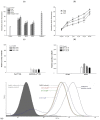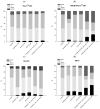Zhankuic Acids A, B and C from Taiwanofungus Camphoratus Act as Cytotoxicity Enhancers by Regulating P-Glycoprotein in Multi-Drug Resistant Cancer Cells
- PMID: 31766413
- PMCID: PMC6995581
- DOI: 10.3390/biom9120759
Zhankuic Acids A, B and C from Taiwanofungus Camphoratus Act as Cytotoxicity Enhancers by Regulating P-Glycoprotein in Multi-Drug Resistant Cancer Cells
Abstract
: Since P-glycoprotein (P-gp)-related multidrug resistance (MDR) remains the most important unsolved problem in cancer treatment, scientists are attempting to find potential structures from natural resources. The aim of the present study was to elucidate whether the triterpenoids from Taiwanofungus camphoratus could reverse cancer MDR by influencing P-gp efflux pump. Substrates efflux assay and P-gp ATPase activity assay were conducted to reveal the molecular mechanisms of P-gp inhibition, while SRB assay, cell cycle analyses and apoptosis analyses were performed to confirm the cancer MDR modulating effects. The results indicated that Zhankuic acids A, B and C (ZA-A, ZA-B and ZA-C) impacted P-gp efflux function in competitive, noncompetitive and competitive manners, respectively. Furthermore, these triterpenoids all demonstrated inhibitory patterns on both basal P-gp ATPase activity and verapamil-stimulated ATPase activity. In terms of MDR reversal effects, ZA-A sensitized the P-gp over-expressing cell line (ABCB1/Flp-InTM-293) and MDR cancer cell line (KB/VIN) toward clinically used chemotherapeutic drugs, including doxorubicin, paclitaxel and vincristine, exhibiting the best cytotoxicity enhancing ability among investigated triterpenoids. The present study demonstrated that ZA-A, ZA-B and ZA-C, popular triterpenoids from T. camphoratus, effectively modulated the drug efflux transporter P-gp and reversed the cancer MDR issue.
Keywords: Taiwanofungus camphoratus; Zhankuic acid; multidrug resistance; p-glycoprotein.
Conflict of interest statement
The authors declare no conflict of interest.
Figures








Similar articles
-
Caffeic Acid Attenuates Multi-Drug Resistance in Cancer Cells by Inhibiting Efflux Function of Human P-glycoprotein.Molecules. 2020 Jan 7;25(2):247. doi: 10.3390/molecules25020247. Molecules. 2020. PMID: 31936160 Free PMC article.
-
β-carotene reverses multidrug resistant cancer cells by selectively modulating human P-glycoprotein function.Phytomedicine. 2016 Mar 15;23(3):316-23. doi: 10.1016/j.phymed.2016.01.008. Epub 2016 Feb 6. Phytomedicine. 2016. PMID: 26969385
-
A novel flavonoid from Fissistigma cupreonitens, 5‑hydroxy‑7,8‑dimethoxyflavanone, competitively inhibited the efflux function of human P-glycoprotein and reversed cancer multi-drug resistance.Phytomedicine. 2021 May;85:153528. doi: 10.1016/j.phymed.2021.153528. Epub 2021 Feb 25. Phytomedicine. 2021. PMID: 33735724
-
Pharmacological strategies for overcoming multidrug resistance.Curr Drug Targets. 2006 Jul;7(7):861-79. doi: 10.2174/138945006777709593. Curr Drug Targets. 2006. PMID: 16842217 Review.
-
Structure, function and regulation of P-glycoprotein and its clinical relevance in drug disposition.Xenobiotica. 2008 Jul;38(7-8):802-32. doi: 10.1080/00498250701867889. Xenobiotica. 2008. PMID: 18668431 Review.
Cited by
-
Current Uses of Mushrooms in Cancer Treatment and Their Anticancer Mechanisms.Int J Mol Sci. 2022 Sep 10;23(18):10502. doi: 10.3390/ijms231810502. Int J Mol Sci. 2022. PMID: 36142412 Free PMC article. Review.
-
Chemoreversal Agents from Taiwanofungus Genus and Their More Potent Methyl Derivatives Targeting Signal Transducer and Activator of Transcription 3 (STAT3) Phosphorylation.Pharmaceuticals (Basel). 2021 Sep 10;14(9):916. doi: 10.3390/ph14090916. Pharmaceuticals (Basel). 2021. PMID: 34577615 Free PMC article.
-
Edible mushrooms trending in food: Nutrigenomics, bibliometric, from bench to valuable applications.Heliyon. 2024 Aug 27;10(17):e36963. doi: 10.1016/j.heliyon.2024.e36963. eCollection 2024 Sep 15. Heliyon. 2024. PMID: 39281488 Free PMC article. Review.
-
Caffeic Acid Attenuates Multi-Drug Resistance in Cancer Cells by Inhibiting Efflux Function of Human P-glycoprotein.Molecules. 2020 Jan 7;25(2):247. doi: 10.3390/molecules25020247. Molecules. 2020. PMID: 31936160 Free PMC article.
-
The role and therapeutic potential of glucose metabolism in multidrug resistance of cancer.Front Cell Dev Biol. 2025 Jun 19;13:1584630. doi: 10.3389/fcell.2025.1584630. eCollection 2025. Front Cell Dev Biol. 2025. PMID: 40612109 Free PMC article. Review.
References
Publication types
MeSH terms
Substances
LinkOut - more resources
Full Text Sources
Medical
Miscellaneous

